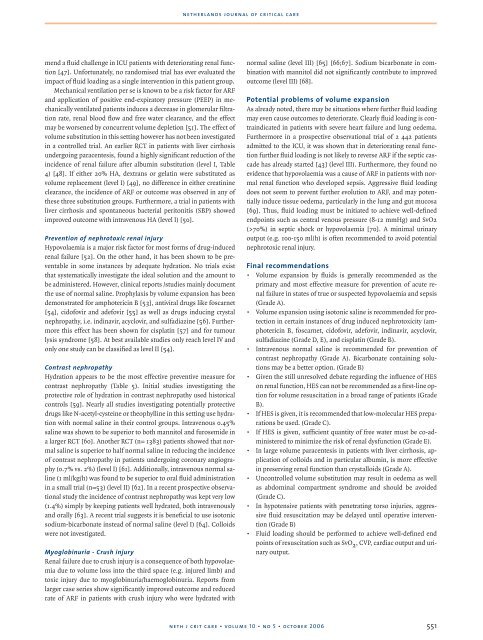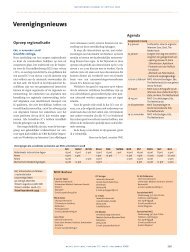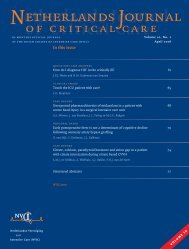Netherlands Journal
NJCC Volume 10, Oktober 2006
NJCC Volume 10, Oktober 2006
- No tags were found...
You also want an ePaper? Increase the reach of your titles
YUMPU automatically turns print PDFs into web optimized ePapers that Google loves.
netherlands journal of critical care<br />
mend a fluid challenge in ICU patients with deteriorating renal function<br />
[47]. Unfortunately, no randomised trial has ever evaluated the<br />
impact of fluid loading as a single intervention in this patient group.<br />
Mechanical ventilation per se is known to be a risk factor for ARF<br />
and application of positive end-expiratory pressure (PEEP) in mechanically<br />
ventilated patients induces a decrease in glomerular filtration<br />
rate, renal blood flow and free water clearance, and the effect<br />
may be worsened by concurrent volume depletion [51]. The effect of<br />
volume substitution in this setting however has not been investigated<br />
in a controlled trial. An earlier RCT in patients with liver cirrhosis<br />
undergoing paracentesis, found a highly significant reduction of the<br />
incidence of renal failure after albumin substitution (level I, Table<br />
4) [48]. If either 20% HA, dextrans or gelatin were substituted as<br />
volume replacement (level I) [49], no difference in either creatinine<br />
clearance, the incidence of ARF or outcome was observed in any of<br />
these three substitution groups. Furthermore, a trial in patients with<br />
liver cirrhosis and spontaneous bacterial peritonitis (SBP) showed<br />
improved outcome with intravenous HA (level I) [50].<br />
Prevention of nephrotoxic renal injury<br />
Hypovolaemia is a major risk factor for most forms of drug-induced<br />
renal failure [52]. On the other hand, it has been shown to be preventable<br />
in some instances by adequate hydration. No trials exist<br />
that systematically investigate the ideal solution and the amount to<br />
be administered. However, clinical reports /studies mainly document<br />
the use of normal saline. Prophylaxis by volume expansion has been<br />
demonstrated for amphotericin B [53], antiviral drugs like foscarnet<br />
[54], cidofovir and adefovir [55] as well as drugs inducing crystal<br />
nephropathy, i.e. indinavir, acyclovir, and sulfadiazine [56]. Furthermore<br />
this effect has been shown for cisplatin [57] and for tumour<br />
lysis syndrome [58]. At best available studies only reach level IV and<br />
only one study can be classified as level II [54].<br />
Contrast nephropathy<br />
Hydration appears to be the most effective preventive measure for<br />
contrast nephropathy (Table 5). Initial studies investigating the<br />
protective role of hydration in contrast nephropathy used historical<br />
controls [59]. Nearly all studies investigating potentially protective<br />
drugs like N-acetyl-cysteine or theophylline in this setting use hydration<br />
with normal saline in their control groups. Intravenous 0.45%<br />
saline was shown to be superior to both mannitol and furosemide in<br />
a larger RCT [60]. Another RCT (n= 1383) patients showed that normal<br />
saline is superior to half normal saline in reducing the incidence<br />
of contrast nephropathy in patients undergoing coronary angiography<br />
(0.7% vs. 2%) (level I) [61]. Additionally, intravenous normal saline<br />
(1 ml/kg/h) was found to be superior to oral fluid administration<br />
in a small trial (n=53) (level II) [62]. In a recent prospective observational<br />
study the incidence of contrast nephropathy was kept very low<br />
(1.4%) simply by keeping patients well hydrated, both intravenously<br />
and orally [63]. A recent trial suggests it is beneficial to use isotonic<br />
sodium-bicarbonate instead of normal saline (level I) [64]. Colloids<br />
were not investigated.<br />
Myoglobinuria - Crush injury<br />
Renal failure due to crush injury is a consequence of both hypovolaemia<br />
due to volume loss into the third space (e.g. injured limb) and<br />
toxic injury due to myoglobinuria/haemoglobinuria. Reports from<br />
larger case series show significantly improved outcome and reduced<br />
rate of ARF in patients with crush injury who were hydrated with<br />
normal saline (level III) [65] [66;67]. Sodium bicarbonate in combination<br />
with mannitol did not significantly contribute to improved<br />
outcome (level III) [68].<br />
Potential problems of volume expansion<br />
As already noted, there may be situations where further fluid loading<br />
may even cause outcomes to deteriorate. Clearly fluid loading is contraindicated<br />
in patients with severe heart failure and lung oedema.<br />
Furthermore in a prospective observational trial of 2 442 patients<br />
admitted to the ICU, it was shown that in deteriorating renal function<br />
further fluid loading is not likely to reverse ARF if the septic cascade<br />
has already started [43] (level III). Furthermore, they found no<br />
evidence that hypovolaemia was a cause of ARF in patients with normal<br />
renal function who developed sepsis. Aggressive fluid loading<br />
does not seem to prevent further evolution to ARF, and may potentially<br />
induce tissue oedema, particularly in the lung and gut mucosa<br />
[69]. Thus, fluid loading must be initiated to achieve well-defined<br />
endpoints such as central venous pressure (8-12 mmHg) and SvO2<br />
(>70%) in septic shock or hypovolaemia [70]. A minimal urinary<br />
output (e.g. 100-150 ml/h) is often recommended to avoid potential<br />
nephrotoxic renal injury.<br />
Final recommendations<br />
• Volume expansion by fluids is generally recommended as the<br />
primary and most effective measure for prevention of acute renal<br />
failure in states of true or suspected hypovolaemia and sepsis<br />
(Grade A).<br />
• Volume expansion using isotonic saline is recommended for protection<br />
in certain instances of drug induced nephrotoxicity (amphotericin<br />
B, foscarnet, cidofovir, adefovir, indinavir, acyclovir,<br />
sulfadiazine (Grade D, E), and cisplatin (Grade B).<br />
• Intravenous normal saline is recommended for prevention of<br />
contrast nephropathy (Grade A). Bicarbonate containing solutions<br />
may be a better option. (Grade B)<br />
• Given the still unresolved debate regarding the influence of HES<br />
on renal function, HES can not be recommended as a first-line option<br />
for volume resuscitation in a broad range of patients (Grade<br />
B).<br />
• If HES is given, it is recommended that low-molecular HES preparations<br />
be used. (Grade C).<br />
• If HES is given, sufficient quantity of free water must be co-administered<br />
to minimize the risk of renal dysfunction (Grade E).<br />
• In large volume paracentesis in patients with liver cirrhosis, application<br />
of colloids and in particular albumin, is more effective<br />
in preserving renal function than crystalloids (Grade A).<br />
• Uncontrolled volume substitution may result in oedema as well<br />
as abdominal compartment syndrome and should be avoided<br />
(Grade C).<br />
• In hypotensive patients with penetrating torso injuries, aggressive<br />
fluid resuscitation may be delayed until operative intervention<br />
(Grade B)<br />
• Fluid loading should be performed to achieve well-defined end<br />
points of resuscitation such as SvO 2 , CVP, cardiac output and urinary<br />
output.<br />
neth j crit care • volume 10 • no 5 • october 2006<br />
551







